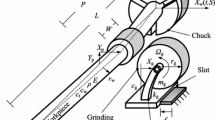Abstract
In this paper, a particular kind of non-regenerative instability in surface grinding is studied. Clear evidences have been collected suggesting that vibrations can occur suddenly even during the first grinding pass, just after wheel dressing. These circumstances exclude workpiece and wheel surface regeneration as instability origin, whereas both surfaces have to be considered initially smooth. On these bases, the stability of the dynamic system constituted by an oscillating ideal wheel (namely without waviness on the surface) immerged in a positional and velocity-dependent process force field has been studied, demonstrating that, under particular conditions, the force field generates an unstable behaviour. The instability occurrence is strictly related to the oscillation direction of the wheel centre, according to the mode shape associated to the dominant resonance, with respect to the direction of the grinding force (identified by the ratio between its tangential and normal components). The analysis leads to the identification of a simple necessary condition for instability occurrence. The analytical results are confirmed by time-domain grinding simulations and compared with experimental evidences.
Similar content being viewed by others
References
Thompson RA (1971) The dynamic behavior of surface grinding Part 1—a mathematical treatment of surface grinding. J Eng Ind 93(2):485–491
Thompson RA (1971) The dynamic behaviour of surface grinding Part 2—some surface grinding tests. J Eng Ind 93(2):492–497
Inasaki I, Karpuschewski B, Lee H (2001) "Grinding chatter—origin and suppression". CIRP Ann Manuf Technol 2(2):515–534
Hesterman D, Stone B (2002) Improved model of chatter in grinding, including torsional effects. Proc Inst Mech Eng K J Multi-body Dyn 216(2):169–180
Inasaki I, Yonetsu S (1969) "Forced vibrations during surface grinding". Bull JSME 12(50):385–391
Inasaki I, Yonetsu S (1968) "Surface waves generated on the grinding wheel". Bull JSME 11(47):922–929
Li H, Shin YC (2006) "A time-domain dynamic model for chatter prediction of cylindrical plunge grinding". J Manuf Sci Eng ASME 128(3):404–415
Li H, Shin YC (2007) A study on chatter boundaries of cylindrical plunge grinding with process condition-dependent dynamics. Int J Mach Tools Manuf 47(10):1563–1572
Leonesio M, Parenti P, Cassinari A, Bianchi G, Monno M (2012) “A time-domain surface grinding model for dynamic simulation”, 3rd CIRP Conference on Process Machine Interactions (3rd PMI), Procedia CIRP, vol 4. Nagoya, Japan, pp 166–171
Wiercigroch M, Krivtsov AM (2001) Frictional chatter in orthogonal metal cutting. Philos Trans R Soc Lond A 359:713–738
Wu DW, Liu CR (1985) “An analytical model of cutting tool dynamics—Part 1: model building, Part 2: verication”. J Eng Ind Trans ASME 107:107–118
Davies MA, Burns TJ (2001) Thermomechanical oscillations in material flow during high-speed machining. Philos Trans R Soc 359:821–846
Gradisek J (2001) Chatter onset in non-regenerative cutting: a numerical study. J Sound Vib 242(5):829–838
Stanescu ND (2009) “Chaos in grinding process”, Wseas Trans Appl Theor Mech 4(4):195–204
Marinescu ID, Hitchiner M, Uhlmann E, Rowe BW, Inasaki I (2007) Handbook of machining with grinding wheels. CRC Press, USA
Inasaki I (2008) "Performance enhancement of grinding processes-mutual interaction between the material removal process and the machine tool". JTEKT Eng J (1004E):3–8
Snoeys R, Brown D (1969) "Dominating parameters in grinding wheel—workpiece regenerative chatter", Advances in machine tool design and research. Proceedings of the 10th International M.T.D.R. Conference, University of Manchester, pp 001–024
Ramos JC, Vinolas J, Nieto FJ (2001) A simplified methodology to determine the cutting stiffness and the contact stiffness in the plunge grinding process. Int J Mach Tools Manuf 41(1):33–49
Norgia M, Annoni M, Pesatori A, Svelto C (2010) Dedicated optical instruments for ultrasonic welder inspection and control. Measurement 43(1):39–45
Author information
Authors and Affiliations
Corresponding author
Appendix 1
Appendix 1
Let the inequality Δq c < 0 be considered, namely
Dividing both members by cos2 α and posing t = tan α with \( -\frac{\pi }{2}<\alpha <\frac{\pi }{2} \), it yields
whose boundary solution is
(both cases sgn Ω = 1 and sgn Ω = −1 must be taken into account). Stating that
the discriminant of the parabola represented by the first term of the (Eq. 24) is always positive. As the coefficient of t2 is always positive as well, the parabola has the vertex belonging to the negative half-plane and a positive concavity; therefore, the negative values are internal to the interval comprised between the solutions t1,2. Going back to the original variable α, inequality solution becomes
Condition (26) leads to the following approximation:
Thus, (27) becomes
Finally, the minimum of the first member of (24) can be easily computed by equating to zero its first derivative. It yields
Rights and permissions
About this article
Cite this article
Leonesio, M., Parenti, P., Cassinari, A. et al. Force-field instability in surface grinding. Int J Adv Manuf Technol 72, 1347–1360 (2014). https://doi.org/10.1007/s00170-014-5725-7
Received:
Accepted:
Published:
Issue Date:
DOI: https://doi.org/10.1007/s00170-014-5725-7



